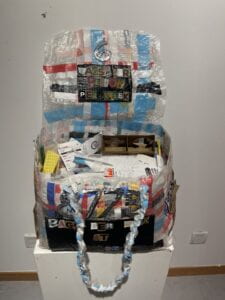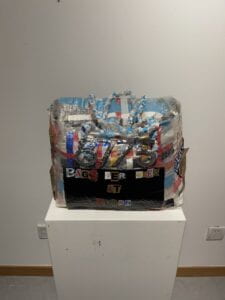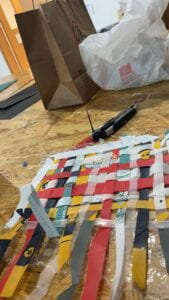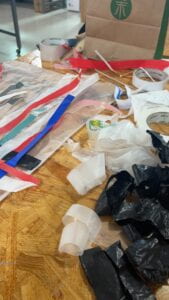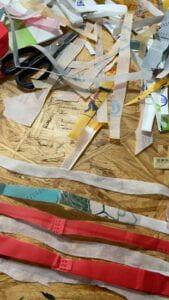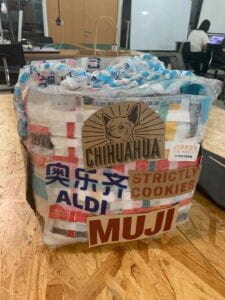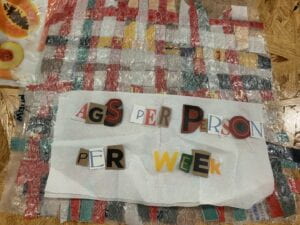“The Bag”
Angel, Lana, and I decided to make a bag out of deconstructed food delivery plastic bags and packaging for our art exhibit. One of the most noticeable aspects of life in China is the food delivery culture. People’s everyday lives are seamlessly intertwined with the ease of ordering meals, yet most people do not consider the quantity of packaging that goes into each delivery, including plastic and paper bags, utensils, containers, and receipts. We amassed a total of about 60 bags after collecting bags from a small sample size of 10 peers over the course of one week, resulting in an average of 6 bags discarded per individual. We calculated that our school community consumes 8775 bags in only one week by multiplying the average number of bags per person by the number of individuals at NYUSH. We wanted to draw attention to this startling discovery through our artwork in order to educate people. To demonstrate the bulk and weight of all the packaging, we chose to load the bag with receipts, plastic utensils, and other packaging trash. We intended to change people’s minds about plastic bags by constructing a labor-intensive and completely functioning bag out of discarded bags.
Process:
We collected our friends’ and roommates’ food delivery trash over the course of a week. After gathering all our bags and packaging, we proceeded to cut our bags into small strips. Plastic strips were then used to weave into sheets that we fused together in between durable clear plastic and bubble wrap. With 6 of these sheets, we used hot glue to assemble them into the formation of a large tote bag, complete with a snap-closure lid. Handles were made by braiding together remaining strips.
To highlight that the bag was created from food packaging, we ripped off restaurant logos from the bags to decorate the sides. Finally, receipts, cutlery, styrofoam, and excess plastic were stuffed into the bag.
Conclusion:
We wanted to raise awareness about the quantity of packaging that is rapidly discarded with every meal delivery order for this project. The bags we gathered ended up being used for both our supplies and data collecting. With data on our community’s use of plastic bags adorning the bag, we intended to create a powerful and informative statement about how many bags are discarded. We were able to breathe new life into bags that consumers did not hesitate to use again by manufacturing a new plastic bag from discarded bags. We were able to create a strong and visually appealing bag out of other people’s trash, demonstrating that plastic bags can be recycled.
Improvements:
If we had more time, we would have collected bags from a greater number of people in order to obtain a more accurate statistic. Furthermore, we would have liked to use all 60 bags gathered to create a larger-than-life bag that would clearly demonstrate the amount of plastic collected.
Awareness:
The most difficult aspect of constructing this bag was the painstaking nature of the process. We had to weave our tiny strips one by one, which took a long time. After going through this time-consuming procedure, I can see why recreated items are frequently so expensive. The price includes the work involved in sorting, preparing, and reassembling recyclable materials, as well as fair compensation and quality assurance. This can be a double-edged sword because high prices dissuade many people from buying sustainable items, so they continue to buy non-sustainable products for the sake of convenience.
